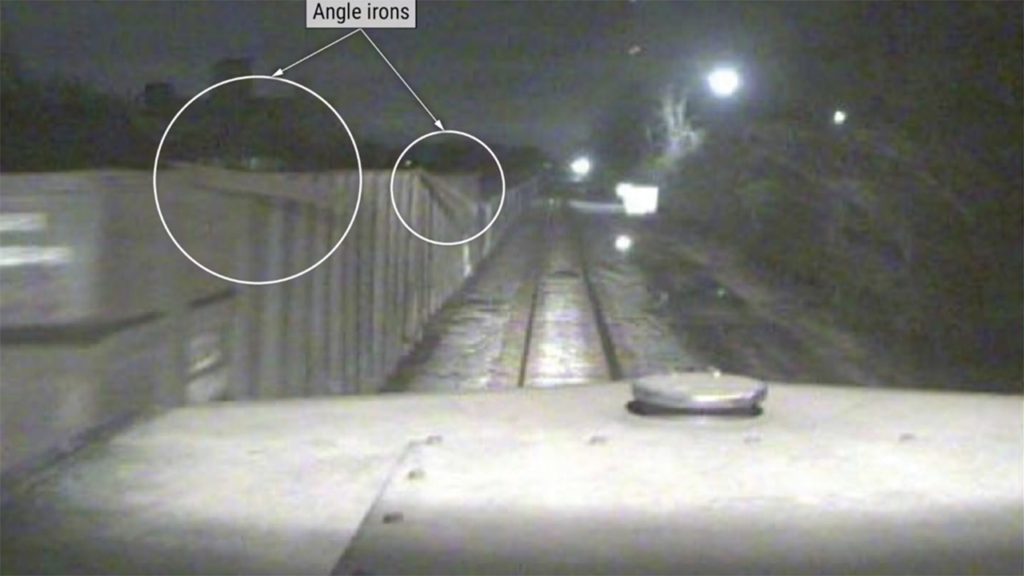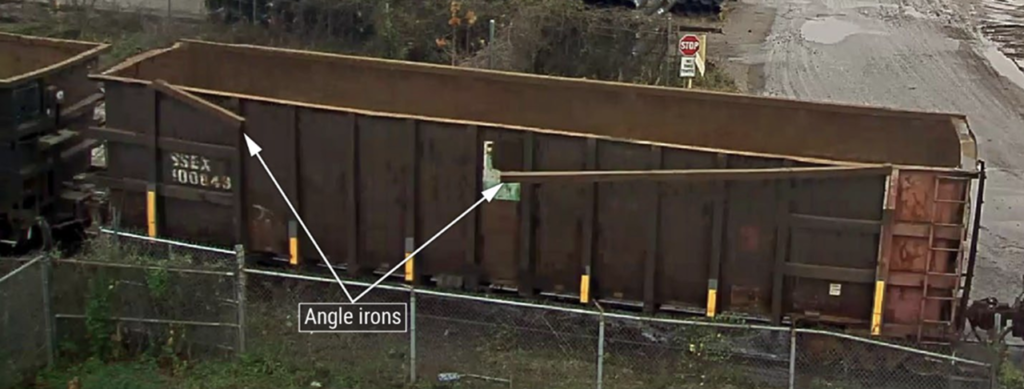NTSB Releases December 2022 NS Accident Report
The National Transportation Safety Board (NTSB) on April 9 issued the final report for its investigation of a Dec. 13, 2022, accident, in which a Norfolk Southern (NS) employee was killed and another injured when a locomotive struck steel protruding from a gondola car on a stationary train near Bessemer, Ala.
The accident’s probable cause, according to the NTSB, “was the hazardous condition of a gondola car that was identified by personnel within a U.S. Pipe facility but not communicated to Norfolk Southern Railway or identified by Norfolk Southern Railway personnel during required pre-departure inspections.”
What Happened?

At about 12:01 a.m. local time on Dec. 13, 2022, the lead locomotive of NS freight train A55-12 (train A55) struck a length of steel angle iron protruding from a gondola car on stationary NS freight train 340-12 (train 340) on the Alabama Great Southern South Subdivision in Bessemer, according to the NTSB report (download below). Train A55 was traveling northbound at about 54 mph on main track 2; train 340 was stopped on main track 1. The gondola car was part of a block of 21 railcars recently added to train 340 from a yard track near a U.S. Pipe recycling facility, NTSB reported. The section of angle iron, it said, was protruding from the top edge of the gondola car on its east side, fouling main track 2 (see Figure 1 and Figure 2, above).
The federal agency noted that visibility conditions at the time of the accident were “dark and clear,” and the weather was 50°F with no precipitation.
NTSB Analysis
According to the NTSB report, northbound NS train A55 struck a section of angle iron protruding from the east side of a gondola car in stationary NS train 340, which was positioned on an adjacent main track near a U.S. Pipe facility. The conductor trainee of train A55 was killed, and a conductor was injured. “Based on the NTSB’s review of surveillance camera images from the U.S. Pipe facility, the accident gondola car was undamaged when it was delivered to the facility on December 4, 2022,” NTSB wrote in the report. “However, images captured on December 7, 2022, after U.S. Pipe employees unloaded the gondola car with a crane, show two angle iron sections protruding from the top edge of one side of the gondola. These images confirm that the gondola was damaged at the U.S. Pipe facility during unloading. The NTSB’s post-accident examination of the accident gondola car identified failed welds along the top edge on the east side. Further examination showed the welds were not part of the gondola’s original construction and had been added later, consistent with an attempt to repair the top cord of the gondola car at an undetermined time before the gondola car was delivered to the U.S. Pipe facility. The welds failed during unloading and caused the angle iron sections to partially separate and protrude from the gondola car.”
As a result, NTSB reported, “one end of an angle iron section protruded enough to foul main track 2 when the gondola car was positioned on main track 1.” Surveillance camera images from the U.S. Pipe facility, along with interviews with U.S. Pipe and contractor personnel, “show that various personnel working in the U.S. Pipe facility were aware of the damage to the gondola car,” according to NTSB. “Caution tape was affixed to the gondola car to show that it was identified as a hazardous condition, and an engineer requested supervisor approval before moving the car within the facility. These actions indicate that personnel, including U.S. Pipe supervisors, were aware that the damaged gondola car could present a hazard, and initially exercised care when moving the gondola car within the facility.”
U.S. Pipe did not inform NS or the crew of train A39 that the gondola car had been damaged, NTSB said. On Dec. 12, 2022, two different NS trains and crews handled the gondola car involved in the accident: train 340 and train A39. The crew of train A39, which included an engineer, a conductor, and a conductor trainee, went on duty on Dec. 12 at 9:01 a.m. and picked up railcars, including the accident gondola car, from the U.S. Pipe facility and positioned them on the hill track, according to NTSB. “Images from a U.S. Pipe surveillance camera show angle iron sections protruding from the accident gondola car as it departed the U.S. Pipe facility,” NTSB reported. (See Figure 3 below.) “When interviewed by the NTSB, the conductor of train A39 reported inspecting both sides of the railcars before moving them, as required by NS operating rule C-100, and did not report any defects. When interviewed by the NTSB, the conductor noted the presence of scrap metal on the ground and the need to pay attention to where he was walking to avoid injury; his line of sight was mostly directed downward toward the ground, brake equipment, and wheelsets. The inspection and movement occurred during daylight hours.” According to NTSB, the inspection did not identify the protruding section of angle iron, “a hazardous condition that train crews are required to identify during pre-departure inspections”; “[h]ad the inspection been performed in a way that checked for objects protruding from the side of each railcar, the damaged gondola car would have been identified and either repaired or removed from the train.”

According to NTSB, later, about 11:15 p.m. on Dec. 12, 2022, train 340 approached the Bessemer yard to pick up railcars from the hill track. “The conductor assessed the walking conditions on the east side of the hill track as unsafe and decided to perform the pre-departure inspection in two parts: the west side of the train on the hill track, and the east side of the train on main track 1,” NTSB reported. “NS rule C-100 allows this division of pre-departure inspections when necessary for crew safety. Based on the NTSB’s review of images and on-site observations of the hill track, walking conditions on the east side of the hill track were unsafe because of a steep incline and limited level ground near the track. Train A55 struck the protruding section of angle iron from the gondola car after the crew moved train 340 to main track 1 but before they had an opportunity to inspect the east side and identify the defective condition. The second pre-departure inspection was planned and partially completed in compliance with NS operating rules under the conditions present in the yard. The first pre-departure inspection should have identified the defective condition but did not.”
About midnight on Dec. 13, 2022, train A55 began passing train 340, according to NTSB. “The engineer of train A55 saw one of the angle iron sections immediately before impact,” it reported. “Outward-facing image recorder data confirmed that the protruding section of angle iron presented a small, difficult-to-see profile under night-time visibility conditions. Because the section of angle iron became visible from the locomotive cab immediately before impact, the engineer of train A55 could not have prevented or mitigated the accident.”
Accident Response
In response to the accident, NTSB said:
- By Jan. 7, 2023, U.S. Pipe had re-trained its personnel “on procedures that require personnel to report railcar hazards to railcar owners and remove affected railcars from service”; this topic is now covered during regular safety trainings. According to NTSB, this training change is “intended to prevent unsafe railcars from leaving the facility.”
- The Institute of Scrap Recycling Industries, Inc., on April 10, 2023, began issuing a bulletin to its members and discussed the Bessemer, Ala., accident at April, May, and July 2023 industry events to raise awareness of the dangers posed by damaged railcars. According to NTSB, these events, reached approximately 8,000 scrap metal recycling industry professionals.
- The Federal Railroad Administration on Dec. 20, 2022, issued a safety bulletin “emphasizing the importance of performing proper visual inspections to identify objects fouling adjacent tracks and, if such a condition is observed, the need to immediately report it.”
- The Association of American Railroads on June 5, 2023, issued a circular letter “warning members of the danger posed by objects extending from railcars and reminding them of the importance of identifying and mitigating the hazard.”
